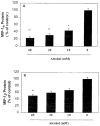Alcohol potentiates HIV-1 infection of human blood mononuclear phagocytes
- PMID: 12500113
- PMCID: PMC4015111
- DOI: 10.1097/01.ALC.0000042148.50808.04
Alcohol potentiates HIV-1 infection of human blood mononuclear phagocytes
Abstract
Background: Acute and chronic alcohol abuse impairs various functions of the immune system and thus has been implicated as a cofactor in HIV infection. The mechanisms by which alcohol affects the function of human immune cells that are the targets for HIV are unknown.
Methods: Human blood monocyte-derived macrophages (MDM) were incubated with or without alcohol (10-40 mM) for 24 hr and then infected with HIV for 24 hr. Culture supernatants were harvested for HIV reverse transcription assay. HIV entry receptor (CCR5, CD4, and CXCR4) expression was determined by reverse transcription-polymerase chain reaction and flow cytometry assays. Beta-chemokines were analyzed using enzyme-linked immunosorbent assay. Different HIV strains (Bal, SF-162, 89.6, and UG024) were used for infection experiments. In addition, ADA (macrophage-tropic strain) and murine leukemia virus envelope-pseudotyped HIV infection was carried out.
Results: Although alcohol had little effect on HIV T-lymphocyte-tropic strain infection, it significantly enhanced HIV R5 strain infection in MDM. The enhancing effect of alcohol on the HIV R5 strain was further evidenced by the observation that the R5 (ADA) strain envelope-pseudotyped HIV infection is markedly increased by alcohol, whereas murine leukemia virus envelope-pseudotyped HIV infection was not affected. Alcohol significantly up-regulated CCR5 receptor expression and inhibited the endogenous production of beta-chemokines by MDM.
Conclusion: Alcohol, through the down-regulation of beta-chemokine production and the up-regulation of CCR5 receptor expression, enhances HIV R5 strain infection of MDM and may have an important role as a cofactor in the progression of HIV disease.
Figures






References
-
- Bagasra O, Bachman SE, Jew L, Tawadros R, Cater J, Boden G, Ryan I, Pomerantz RJ. Increased human immunodeficiency virus type 1 replication in human peripheral blood mononuclear cells induced by ethanol: potential immunopathogenic mechanisms. J Infect Dis. 1996;173:550–558. - PubMed
-
- Bagasra O, Kajdacsy-Balla A, Lischner HW. Effects of alcohol ingestion on in vitro susceptibility of peripheral blood mononuclear cells to infection with HIV and of selected T-cell functions. Alcohol Clin Exp Res. 1989;13:636–643. - PubMed
-
- Bagasra O, Kajdacsy-Balla A, Lischner HW, Pomerantz RJ. Alcohol intake increases human immunodeficiency virus type 1 replication in human peripheral blood mononuclear cells. J Infect Dis. 1993;167:789–797. - PubMed
-
- Bautista AP. Acute alcohol intoxication and endotoxemia desensitize HIV-1 gp120-induced CC-chemokine production by Kupffer cells. Life Sci. 2001;68:1939–1949. - PubMed
-
- Berger EA, Doms RW, Fenyo EM, Korber BT, Littman DR, Moore JP, Sattentau QJ, Schuitemaker H, Sodroski J, Weiss RA. A new classification for HIV-1. Nature. 1998;391:240. - PubMed
Publication types
MeSH terms
Substances
Grants and funding
LinkOut - more resources
Full Text Sources
Medical
Research Materials

